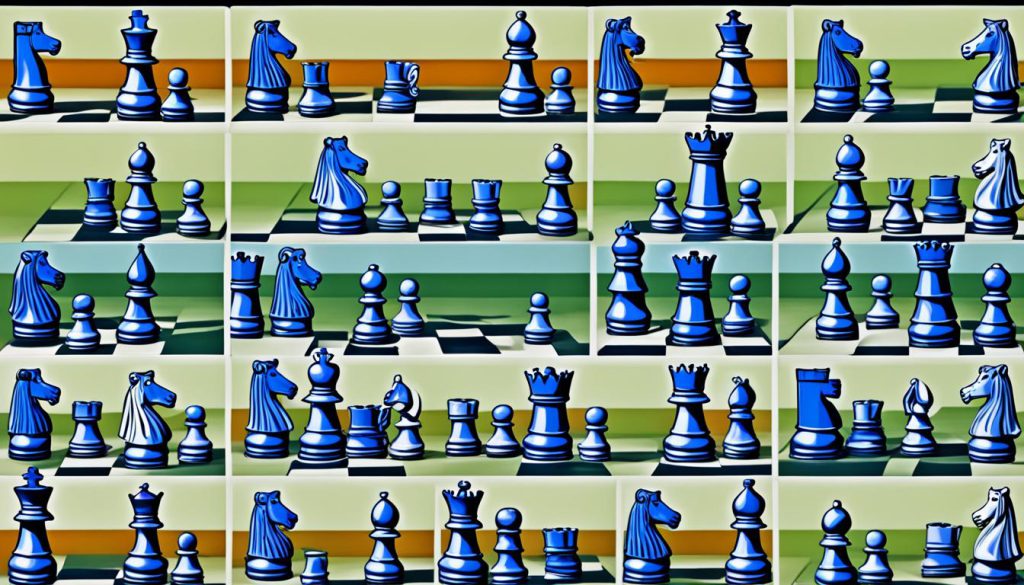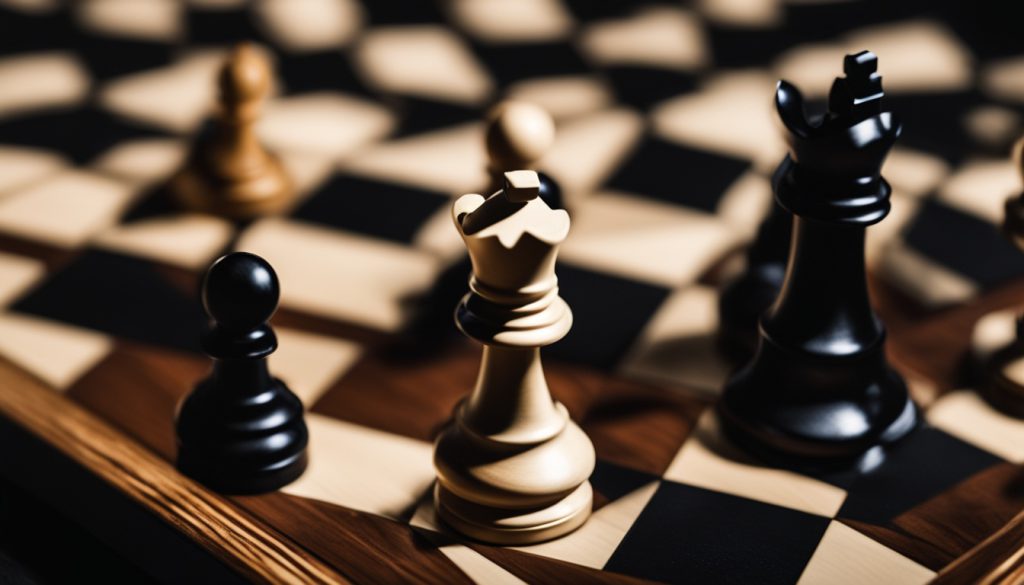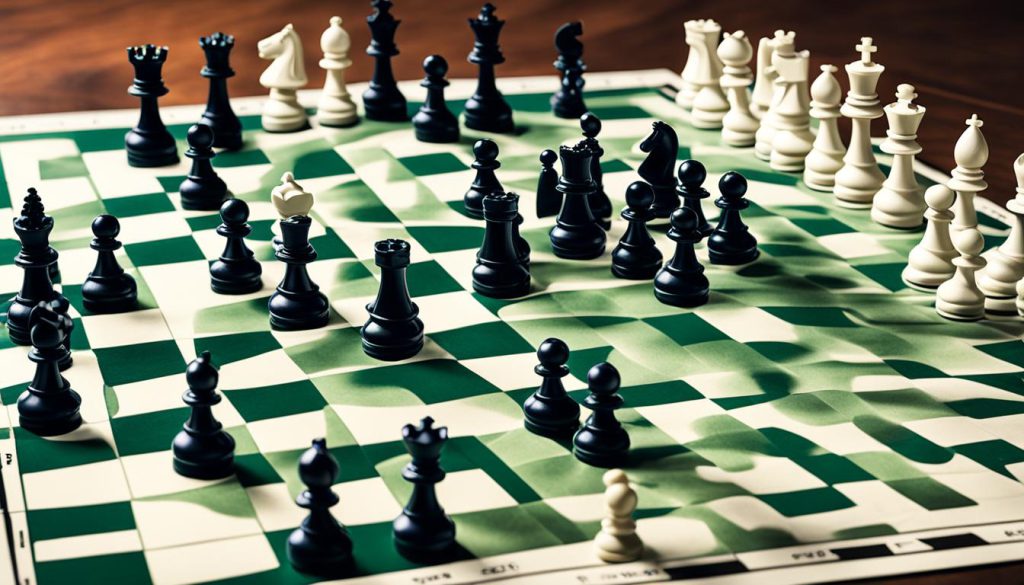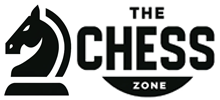When I started with chess, I thought it was about moving pieces on a board. But I soon learned it’s much more. It’s about strategy and thinking ahead. Every move creates a new situation. To master chess basics, I dived into learning these fundamentals. It’s been both hard and thrilling. For beginners like myself, guides are crucial. They light the way to understanding complex strategies.
Learning chess has shown me every choice matters. The game starts with a setup that follows FIDE rules. This setup is the beginning of a duel of minds. Controlling the center of the board is vital. It can change the game’s outcome. Protecting your king needs careful planning and strategy.
I’ve gained a deep respect for chess’s complexity. The game ends with a checkmate, not by capturing all pieces. This happens when the king has no legal moves left. Studying chess has taught me to value position over capturing pieces. I’ve learned special moves like castling and promoting pawns. With each game, my understanding and strategy grow.
Key Takeaways
- The foundation of chess lies in understanding and mastering the pieces’ movements and the initial board setup.
- Chess strategies for novices must emphasize the importance of controlling the board’s center as a winning tactic.
- Special moves such as castling, en passant, and promotion are critical to achieving victory.
- A deep appreciation for the pawn’s role and its unique complexities can offer a strategic edge.
- For beginners, learning to identify and execute fundamental checkmate patterns is key to success in chess.
- Simultaneously focusing on maintaining the safety of one’s own king while targeting the opponent’s is crucial.
- The journey to chess mastery is continuous, blending learning, practice, and strategy to cultivate a winning game.
Understanding the Chessboard Layout
If you’re new to chess rules for beginners, start with the basics: the chessboard. Knowing that a light-colored square should be at the bottom right is key. This knowledge is my first step into the strategic game of chess. Every square on the board represents a potential battle zone.
The chessboard setup is simple but deep. It’s a grid of light and dark squares, ready for action. The pawns line up in the second row, acting as the first line of defense. They prepare to turn into more powerful pieces. This setup isn’t just about placing pieces. It’s about laying the groundwork for future strategies and unseen moves.
My major pieces take their places in the front row. Rooks sit in the corners, knights are next, ready for their unique moves, and bishops are set to cut across. The king and queen, central to my strategy, are prepared to lead or fall. This setup dictates the game’s flow from the opening moves to the final battle.
The queen’s placement on her color is a silent rule for order. This setup predicts the game’s opening and its critical moments. It sets the scene for mastering the game’s different phases, from start to finish.
Understanding the chessboard is crucial for strategic planning. It ensures that my moves are more than random; they’re part of a larger plan. Looking at the board shows the endless possibilities chess offers.
Every game is a new lesson in the intricate world of chess, with each of the 64 squares telling its own story. As a beginner, I find that chess is not just a game. It’s a journey into a world filled with lessons and new discoveries waiting at every turn.
Recognizing the Value of Each Chess Piece
As I explore chess tactics 101, knowing the value of each piece is key. It helps me develop my basic opening strategies. This knowledge is the heart of any beginner chess guide.
Pawn Importance and Movement
Pawns may look simple, but they’re crucial in chess openings explained. Each pawn is worth 1 point. They can turn into any piece, except the king, on the other side. This shows the depth of chess strategies for novices.
Knight’s Unique “L” Move
The knight moves in an “L” shape, a key point in chess basics 101. Valued at 3 points, knights are vital early in the game. Their flexibility is a core chess principle.
Bishop’s Diagonal Dominance
Learning about bishops’ power in learn chess basics was eye-opening. They’re worth 3 points, like knights. Bishops are strongest when paired, a key lesson in chess tactics 101.
Rook’s Straight Paths
Rooks move in straight lines and highlight basic checkmate patterns. Their value of 5 points shows their strength. This is especially true in basic opening strategies and endgames, as any beginner chess guide notes.
Queen’s Versatile Power
The queen is the most powerful, worth 9 points. Chess strategies for novices emphasize its role. It’s important for attacking and defending in basic checkmate patterns.
The King’s Vital Role
The king’s role is to avoid checkmate, making it invaluable. Keeping it safe is crucial in chess openings explained. This is a fundamental chess concept.
Remembering beginner chess tips, let’s review the chess piece values:
| Piece | Value | Function | Strategic Importance |
|---|---|---|---|
| Queen | 9 | Offense and defense | Central to strategies |
| Rook | 5 | Endgame strength | Connectivity and power |
| Bishop | 3 | Diagonal coverage | Efficient in pairs |
| Knight | 3 | Early game agility | Complexity in movement |
| Pawn | 1 | Offense and promotion | Structural foundation |
| King | N/A | Game objective | Continually safeguarded |
Looking at chess’s history, from Howard Staunton’s Chess Player’s Handbook to the Modenese School, chess evolution is fascinating. The game’s strategies have grown with time. Chess960 brings new strategies, showing chess’s rich tradition. It inspires everyone, from beginners to experts.

Critical Chess Concepts for Beginners
Embarking on my chess journey, I’ve learned there’s more to it than just moving pieces. Understanding essential chess concepts is crucial for improving my game. These principles help shape my strategic thinking.
First, I focus on controlling the board’s center. This control helps me lead the game and set a strong foundation for my moves. I aim to position my pieces so they have maximum influence, gaining territory and launching attacks.
“A Chessboard’s center is the launching pad from which all your pieces explode into action. Decisive control here means a direct influence on all parts of the board.” – Understanding this is elementary within any beginner chess guide.
Keeping my pieces safe is vital. I learn to avoid losing them for no reason and make sure they support each other. Each piece plays a role in a bigger strategy, so their safety helps towards a winning endgame.
After the opening, finding a good plan is next. I work to strengthen my control of the center and plan potential attacks. It’s important to adjust to new developments during the game.
Dan Heisman’s “Everyone’s Second Chess Book” helped me understand the importance of winning material. It’s about taking opponent’s pieces without unnecessary trades. This approach aims for an advantageous endgame.
The world of chess is deep and rich with history. Since around 1475, it has evolved into a complex mix of art, science, and sport. It combines old concepts with new technologies, like the enduring Staunton design and advanced chess engines.
| Chess Milestones | Impact on Beginners |
|---|---|
| Steinitz – First World Champion in 1886 | Established the competitive framework. |
| 64-Square Board Formation | Classic structure requiring control for success. |
| FIDE Rule Revision in 2023 | Ensuring a modern understanding of guideline changes. |
| Deep Blue’s 1997 Victory | Integrates modern computing into strategy development. |
| FIDE’s Global Governance | Signifies the universal scope of chess strategy. |
As a new player, understanding essential chess concepts has deepened my respect for chess strategy. My aim is not just to play but to master this game. With a solid grasp of the basics and an eye on its evolution, I start my journey balanced between respect and competitiveness.
Chess Basics 101: Opening Moves Strategy
Starting strong in chess is crucial. I’ve turned to “Chess Basics 101: Learn the Essential Moves & Strategy” by Fred Wilson. It’s here I’ve begun to grasp chess openings. The Fédération Internationale des Échecs (FIDE) sets chess rules, blending strategy and skill right from the start.

Controlling the Center with Pawns
Dominating the board’s center is key. I discovered each pawn could be a hero, commanding the center. Advancing the King’s pawn two squares (e4) opens up opportunities for my Bishop and Queen, as Wilson explains.
Developing Knights and Bishops Early
Moving beyond pawns, bringing bishops and knights into play early on is vital. I learned this from Wilson’s book, filled with diagrams and illustrations. This move prepares them for the battle ahead, a core chess principle endorsed by FIDE.
The Importance of Kingside Safety
Keeping the King safe is fundamental. Castling Kingside protects the King and activates the rook. “Chess Basics 101” shows that castling is a key defensive strategy. It’s a critical move in chess openings.
Reading Fred Wilson’s book has greatly improved my understanding of chess. It covers the basics of pawn roles, knight and bishop moves, and protecting the kingside. With my House of Staunton chess set, I practice these strategies, gaining confidence and insight into chess.
Elementary Tactics to Outmaneuver Opponents
Chess basics 101 show us that tactics are key to beating our foes. Learning moves like pinning and skewering is like knowing the rules of a game. If you know your moves, you can lead the game. It’s important to make every move count, aiming to better our position or shake up the opponent’s setup.
Understanding Pins and Skewers
Learning about pins and skewers in chess opens new strategies. Pins trap an opponent’s piece by targeting a more valuable one behind it. Skewers make a valuable piece move, leaving a weaker piece exposed. Recognizing these moves helps avoid errors and traps enemy pieces. It’s like a quarterback reading defenses to win.
Forks: Attacking Two Pieces at Once
Using a fork attack, especially by a knight, upgrades your game. A knight can attack two pieces, forcing the enemy to choose which to save. Will they save the queen or a rook? It’s often a win-win for us. This move has helped me gain material advantage and lead the game.
Discovering Discovered Attacks
Surprise attacks are as effective in chess as in battle. Discovered attacks catch the opponent off guard, allowing us to strike unexpectedly. Knowing these attacks is crucial for beginners. The goal is to surprise the opponent and then attack when they least expect it, leading to their defeat.
In chess, using tactics like pins, skewers, forks, and discovered attacks is like playing art. These moves create excitement and change the game’s flow. A saying in chess is, a good player plans the next move, but a great player plans several ahead. Thinking one step ahead is my goal, similar to how football strategies win games. A well-placed chess piece can change the game just like a key play in football.
Chess Strategies for Novices: Looking Ahead
In my chess journey, seeing the future moves is key. I’ve learned to learn chess basics and think ahead. It’s vital in any beginner chess guide to know how today’s moves affect tomorrow.
Chess has many rules to start strong. For example, Rule #1 says speedy piece development creates a strong position. So, I make every move count, making my pieces active and strong.
Rule #4 tells us not to move the same piece a lot early on. This reminder helps me be efficient and prepare for the middlegame. It’s about laying a solid foundation.
Rule #6 guides me to castle my King by move 10. It’s crucial for safety and setting up my pieces right. This often means being strong or weak.
By Rule #8, linking the Rooks is essential. They symbolize my development peak, readying me for bigger plans.
Rule #10 is about attacking as my pawns suggest. This advanced tip tells us that good positions lead to victory.
| Strategic Rule | Objective | Outcome |
|---|---|---|
| Rule #1: Develop Rapidly | Strong early-game position | Active, coordinated pieces |
| Rule #4: Avoid Redundant Moves | Efficient development | Swift transition to middlegame |
| Rule #6: Castle Early | King safety, piece coordination | Strong defensive formation |
| Rule #8: Connect Rooks | Complete initial development | Increased tactical readiness |
| Rule #10: Follow Pawn Structure | Exploit weaknesses, positional play | Control and strategic planning |
To really learn chess basics, I found that these rules build my game plan. They’re in the beginner chess guide for a reason. They teach me chess is about future moves and positions, not just now.
A Step-by-Step Guide to Basic Checkmate Patterns
I’ve worked hard to master basic checkmate patterns. This skill boosts my game. It’s key for everyone, from chess rules for beginners to pros. These patterns clinch a win, sharpen chess tactics, and deepen your grasp of the game.

Two-Rook Mate: A Classical Strategy
We often start with openings in chess. Yet, it’s the endgame that counts, like the Two-Rook Mate. This strategy uses both rooks to corner the rival king. It proves how vital rooks are. They move freely across the board, perfectly setting up checkmate.
Queen and King Mate for a Sure Victory
The queen’s power is a basic chess concept. She moves any direction, far and wide. This power is deadly in the Queen and King Mate.
I use the queen to box in the enemy king, with my king’s help. This duo often leads straight to winning.
The Role of Minor Pieces in Checkmates
Minor pieces like knights and bishops play a big role in checkmates. Their unique moves can surprise and lead to victory. Chess for beginners shows how these pieces are important. With smart play, even the smallest pieces can checkmate.
Learning chess is exciting and rewarding. Understanding each piece’s moves makes the game rich. I often visit chess rules for beginners to learn more. This continual learning ensures every game is dynamic and fun.
How to Master Chess Openings Explained
When I started to learn chess basics, I learned that knowing the essential chess concepts changes everything. The chessboard goes from confusing to full of strategic chances. Learning about chess openings explained is key, especially for beginners wanting to know about basic opening strategies.

But knowing openings is more than just memory; it’s about knowing why each move matters. Let’s dive into some openings and strategies that are now key parts of my learning.
Exploring the King’s Pawn Opening
I began with the King’s Pawn Opening (1. e4). It’s great for taking the center early on. This lets other pieces develop more smoothly. Taking the center helps in building both material and positional advantage.
Defending Against Common Openings
It’s also vital to react well to common openings. This includes King’s Pawn and Queen’s Pawn openings. I’ve learned from every chess strategies for novices guide that reacting and counter-strategizing is key. The Sicilian Defense (1…c5), among others, has shown me how deep and flexible chess can be.
Adopting the London System as a Beginning Player
The London System has been great for me as a beginner. It’s strong and works well against many opponents’ moves. It’s perfect because it doesn’t require learning too much theory right away. This matches well with my learning level as a chess beginner seeking a strong opening strategy.
As I continue to learn chess basics, getting to know these basic opening strategies lays a strong base. Each opening I study is like adding a line to my chess story. Chess openings are more than just moves to remember. They are worlds to discover, full of new things for anyone starting their chess journey.
Common Mistakes to Avoid in Chess
Mastering chess means learning key principles and avoiding common mistakes. For beginners, knowing how each piece moves is crucial. In chess tactics 101, I’ll cover common errors new players should avoid.
It’s important to use all your chess pieces. Not using a piece is like it doesn’t exist. Often, players focus too much on pawns, which can hurt the game.
Moving the queen out too early is risky. It makes her a target. Also, focusing too much on one piece wastes valuable moves that could strengthen your position.
The table below shows how early game piece development is key in chess tactics 101.
| Chess Piece | Recommended Development | Potential Risk if Neglected |
|---|---|---|
| Pawns | Move towards the center; two squares on initial move | Too many pawn moves can slow the development of other pieces |
| Knights & Bishops | Develop early towards the center | Not doing so can lose control and give your opponent an edge |
| Queen | Keep her safe early on to prevent attacks | Being too aggressive early puts her at risk |
| Rooks | Clear pawns for movement; use in castling | Not using them can weaken your defense and attack |
Castling is a key move that protects your king and prepares your rooks. Moves like ‘en passant’ and promoting a pawn can change the game.
Controlling the center of the board is crucial. It sets up powerful attacks. Learning these tips is vital for beginners to avoid early losses.
Chess is about strategy, timing, and how the pieces work together. It’s about finding the path to victory.
Essential Chess Concept: Board Control and Center Domination
In my journey through a beginner chess guide, I’ve found control of the board and center domination to be key. These principles are foundational to chess basics 101. They dictate the strategic flow of a match. Grasping these ideas has profoundly changed how I view the game, moving past the simple chess rules for beginners.
Pawn Structures that Win Games
Pawn placement can make or break a chess game. Chess coach Vladimir Zak taught champions like Spassky and Kamsky to prefer open positions. This approach sharpens your initiative. For example, the moves 1.d4 d5 2.c4 show the strength of a solid pawn center. This lets White dominate the center without losing pieces, often leading to a strong position.
Knowing specific structures, like the Isolated Queen’s Pawn (IQP), opens up aggressive plays. Building a strong basic opening strategy includes knowing when to break with your pawns. According to Grandmaster Agrest, without a pawn break, there’s no plan. It’s also smart to use moves like a4 or b3 to challenge Black’s queenside setup.
Positional Play vs. Tactical Combats
Chess involves both positional play and tactical battles. Positional play focuses on careful planning. Tactics look for immediate advantages. Learning to blend basic opening strategies with tactical moves has been essential.
My game changed when I began playing with purpose, unlike aimless moves seen after the French opening. Recognizing the board’s layout and planning every action, from pawn moves to piece positioning, revolutionized my play. It helped me master key strategies, like managing the central tension or aiming at an opponent’s weak points.
As I aim to master chess, solving daily puzzles has honed my calculation skills, an area I once found tough. Diving deep into both the positional game and tactical exercises is crucial. This is how a beginner truly advances into strategic depth.
Defensive Strategies: Shielding Your King and Pieces
Keeping your king safe and your pieces secure is key to winning in chess. For beginners, it’s important to learn how to protect your king and important pieces. This can turn the game around for you. Let’s look at some defense tactics to help you get better at chess.
Understanding When and How to Castle
Learning to castle is a top tip for beginners. It keeps your king safe and brings your rook into play. You need to know the right time to castle and make sure the path is clear. If you don’t castle, your king could be at risk.
Preventing Dangerous Threats Early On
Being alert from the start is crucial in chess. Spotting threats like forks, pins, or skewers early helps you defend better. This approach requires you to watch your opponent closely and keep your pawns safe. It’s all about being one step ahead.
Applying these tips, like when to castle and how to avoid early threats, will deepen your chess knowledge. But remember, endgames need a strong defense to turn the game in your favor.
| Endgame Scenario | Defensive Strategy | Resulting Outcome |
|---|---|---|
| Knight and Rook Pawn | Pawn on seventh rank, with knight supporting | Leads to a draw |
| Rook vs. Pawn | Back-rank defense in a corner | Common fortress against horizontal checks |
| Bishop and Wrong Rook Pawn | Pawn on seventh rank, opposite-colored bishop | Results in a draw |
| Two Minor Pieces vs. Queen | Strategic positioning to avoid zugzwang | Can lead to a draw |
Mastering endgame defenses takes practice. Recognize patterns like a rook protecting its king in a corner. Combining this with daily puzzles and learning forcing moves will improve your defense. This makes you a tougher opponent in chess.
Enhancing Skills Through Chess Puzzles and Endgames
As an aspiring chess enthusiast in the global community of 800 million players, I’ve embraced chess puzzles and basic endgame patterns. These methods are key for anyone wanting to grasp chess basics well. They’re essential yet often overlooked steps towards becoming skilled.
Practicing Tactics with Chess Puzzles
Learning to maneuver on the 64-square board using 16 pieces is just the start. For deeper tactical insight, I turn to chess puzzles. They help sharpen my understanding of strategic piece movements. A study by the University of Amsterdam showed a link between puzzle success and higher Elo ratings. Engaging with puzzles helps grasp game mechanics, from basic checkmate patterns to complex traps found in works like “Rook Endgames from Morphy to Carlsen” and “400 Chess Strategy Puzzles” by Martyn Kravtsiv.
Importance of Knowing Basic Endgames
My journey has proven the value of mastering basic checkmate patterns and endgame strategies. These aspects mirror real games found in “Understanding Pawn Endgames” and “Secrets of Queen Endgames“. They’ve greatly enhanced my decision-making. Exploring openings in “Modern Chess Opening Repertoire for White” has shown me how they lead to winning endgames. The known difficulty players have with endgames versus middlegames is a challenge I’m overcoming through dedication and analysis.
Active Learning: The Role of Playing Regularly and Reviewing Games
Mastering the chess rules for beginners requires active learning. This means playing games often and reviewing them. Every game, whether won or lost, teaches valuable lessons. This helps improve my chess strategies for novices. Reflecting on past games sharpens my skills and deepens my understanding of chess basics.
Learning chess strategies for novices goes beyond knowing moves. It’s about understanding the game’s mental aspects. Studies show chess boosts cognitive skills. Challenging myself in chess sharpens my gameplay and mental agility.
Let’s explore how research links cognitive improvements to learning chess:
| Year & Source | Research Findings | Implications on Chess Learning |
|---|---|---|
| 2004 – Barnes LL et al. | Cognitive decline with inadequate social resources. | Shows the need for a chess community for social and cognitive engagement. |
| 2007 – Raschetti R et al. | Efficacy of cholinesterase inhibitors in mild cognitive impairment. | Implies chess could delay or lessen cognitive issues. |
| 2008 – Green CS et al. | Brain training effects on brain plasticity. | Suggests learning chess helps with mental flexibility and learning. |
| 2009 – Tang YY et al. | Positive effects of attention training. | Highlights chess’s role in boosting focus and attention to detail. |
Chess rules for beginners are more than a hobby; they’re a way to train your brain. Active chess learning enhances my gameplay and soft skills. It improves problem-solving and strategic thinking. Chess also boosts memory and attention, helping me in life, not just in games.
Playing, reviewing, and practicing chess is crucial for skill growth. This approach, backed by research, can improve your game. It helps you predict moves, spot patterns, and build strategies. This is what makes a notable chess player.
Conclusion
Looking back at chess basics 101, I see a journey of endless learning and practice. Each chess piece, from the simple pawn to the majestic king, is crucial. Learning the rules of chess and moves like castling and pawn promotion has deepened my game knowledge.
Following beginner tips has kept me from common mistakes and boosted my tactical thinking. I make sure my pawns and rooks are well-placed for victory. Each move I make is carefully thought out, aiming to protect my king and achieve checkmate.
I invite all who love this game of strategy and brains to join in. Play chess, work hard, and think over each game. Let the movements of knights, bishops, and pawns lead you to control the board and win. Every match teaches me, win or lose, that chess is an endless journey of learning and strategy.
Source Links
- https://en.wikipedia.org/wiki/Rules_of_chess
- https://www.chess.com/forum/view/for-beginners/chess-basics-101-tips-and-tricks-for-beginner-success
- https://www.365chess.com/view/chess-pieces-names-values-and-moves/
- https://en.wikipedia.org/wiki/Talk:Chess_piece_relative_value
- https://forum.mrmoneymustache.com/welcome-to-the-forum/resources-for-learning-to-play-chess/
- https://en.wikipedia.org/wiki/Chess
- https://www.houseofstaunton.com/101-questions-on-how-to-play-chess.html
- https://www.airuniversity.af.edu/JIPA/Display/Article/2820739/the-polar-trap-china-russia-and-american-power-in-the-arctic-and-antarctica/
- https://www.viqtorysports.com/how-to-understand-american-football-beginners-guide/
- https://www.chess.com/article/view/the-principles-of-the-opening
- https://www.chessfornovices.com/chessstrategy101.html
- https://chesspathways.com/chess-openings/
- https://www.dicebreaker.com/games/chess/how-to/how-to-play-chess
- https://www.chessstrategyonline.com/content/tutorials/how-to-start-a-game-of-chess-opening-principles
- https://www.chess.com/blog/Illingworth/a-crash-course-in-understanding-1-d4
- https://www.nurtr.com/chess-dream-room-details/improving-pieces
- https://en.wikipedia.org/wiki/Fortress_(chess)
- https://www.nurtr.com/chess-dream-room-details/introduction-to-defence
- https://chessify.me/blog/how-to-learn-chess
- http://www.gambitbooks.com/
- https://blog.sixtyfoursquares.com/what-can-solving-chess-puzzles-tell-us-about-our-chess-skills-efa31d4edf17
- https://www.ncbi.nlm.nih.gov/pmc/articles/PMC3461277/
- https://files.eric.ed.gov/fulltext/ED421252.pdf
- https://www.universityxp.com/blog/2022/3/29/what-is-game-balance
